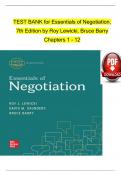Exam (elaborations)
TEST BANK For Essentials of Negotiation, 7th Edition by Roy Lewicki, Bruce Barry, Verified Chapters 1 - 12, Complete Newest Version
- Course
- Institution
TEST BANK For Essentials of Negotiation, 7th Edition by Roy Lewicki, Bruce Barry, Verified Chapters 1 - 12, Complete Newest Version TEST BANK For Essentials of Negotiation, 7th Edition by Roy Lewicki, Bruce Barry, Verified Chapters 1 - 12, Complete Newest Version TEST BANK For Essentials of N...
[Show more]



